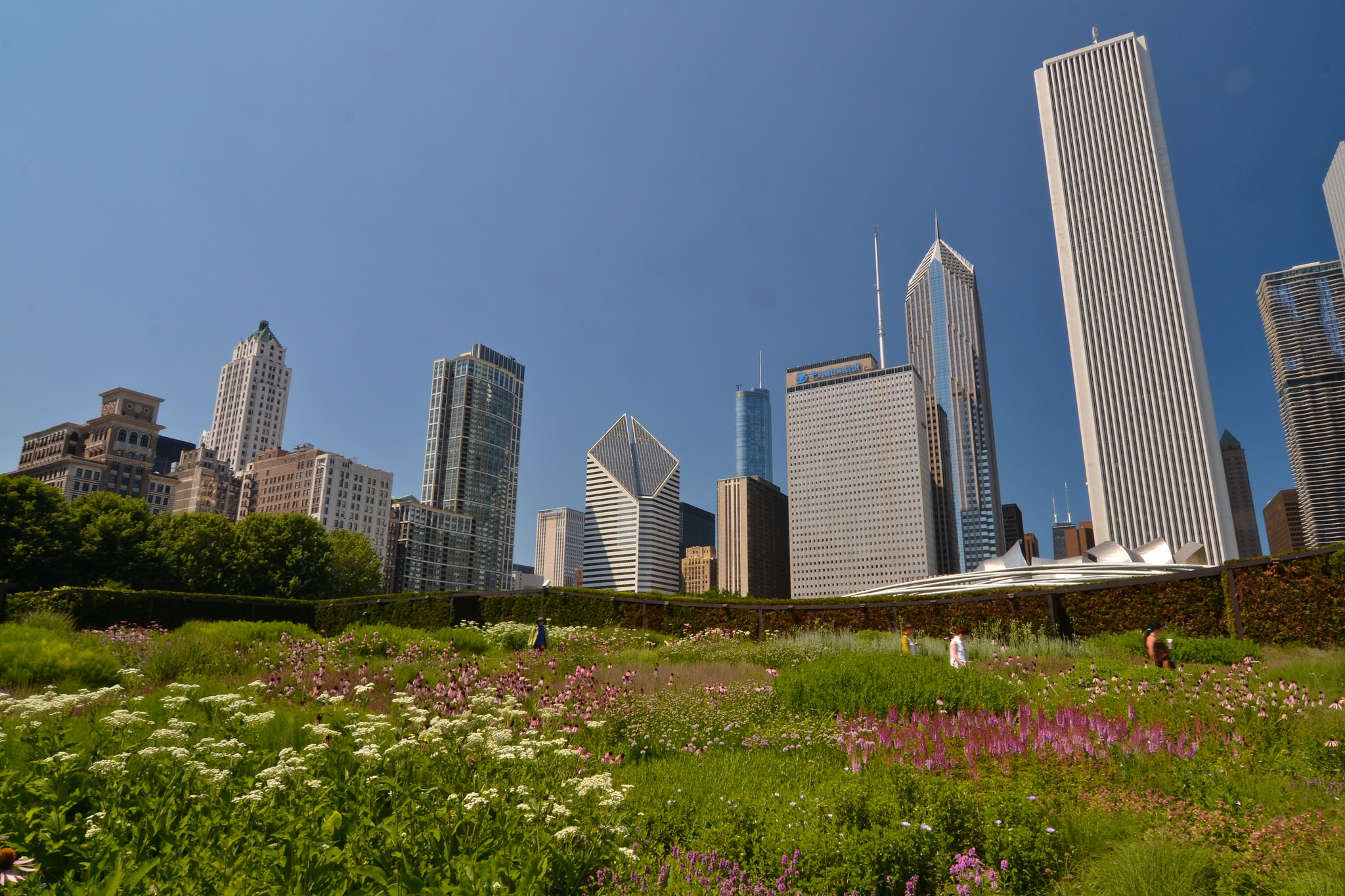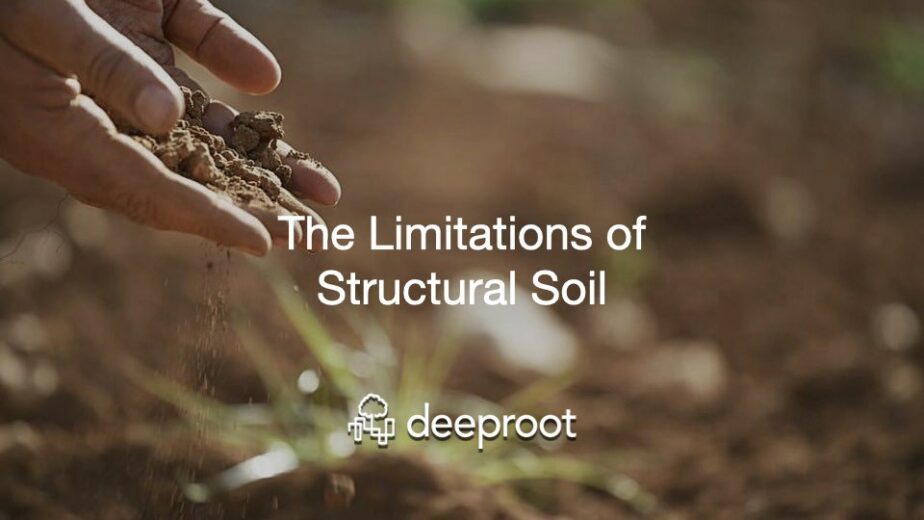Bioretention media is an important topic in the design world. As green infrastructure solutions gain acceptance, there is increased focus on finding the most effective media for on-site stormwater management. But there isn’t (yet) a lot of agreement on what the media consists of, and how to make it both functional for stormwater while being friendly for tree growth. Most of the debate is centered around how much fines (silt and clay) is allowable.
Bioretention media specifications typically greatly limit fines content in order to protect from failure due to clogging – infiltration rates in a bioretention system can decrease significantly, to the point of failure, over time due to sedimentation or compaction. Typical limits are maximum 5% clay, or maximum 12% fines (soil particles passing through the 200 sieve). But does research support the belief that media with more than 12% fines is unsuitable for bioretention? There have been documented failures of bioretention media with more than 5% clay – but are there also documented successes? While soil texture indisputably influences soil infiltration rates, how important is it compared to other factors? It turns out to be not as significant as we assume.
It’s important to ask these questions because higher fines fractions can actually be beneficial for bioretention: (1) they increase soil water and nutrient holding capacity (allowing greater plant diversity and vigor), (2) they improve pollutant removal, and (3) they improve soil structure. Additionally, increasing the maximum allowed fines content increases the number of projects where re-using native soils may be feasible – a great advantage from a sustainability viewpoint.
What is the value of fines?
To unpack the value of fines in bioretention media, we need to first understand how much soil texture affects infiltration rates. The primary concern with using soils with more than 12% fines is that infiltration rates may not be adequate in such soils. However, infiltration rates of some natural soils with more than 12% fines indicate that bioretention with such soils should be feasible (with a reasonable maximum clay and fines content limit).
Table 1, below, is adapted from Saxton and Rawls (2006). Many regulations require a minimum 1†(2.5 cm) per hour infiltration rate. Even a soil with 35% fines (sandy loam) can still have a saturated conductivity of 2 inches (5 cm) per hour! That is 3 times the amount of fines typically allowed in bioretention media. Additionally, note that even a sandy soil has 12% fines, so limiting fines content to 12% means only sandy soils are allowed.
| Texture Class | Sand (%) | Silt (%) | Clay (%) | Total Fines (%) | Saturated Conductivity |
| Sand | 88% | 7% | 5% | 12% | 4.25 in/10.8 cm per hour |
| Loamy sand | 80% | 15% | 5% | 20% | 3.81 in/9.6 cm per hour |
| Sandy loam | 65% | 25% | 10% | 35% | 1.98 in/5 cm per hour |
| Loam | 40% | 40% | 20% | 60% | 0.61 in/1.5 cm per hour |
| Silty Loam | 20% | 65% | 15% | 80% | 0.63 in/1.6 cm per hour |
| Silt | 10% | 85% | 5% | 90% | 0.87 in/2.2 cm per hour |
Table 1, saturated conductivity of selected soil textures (adapted from Saxton and Rawls 2006)
The infiltration rates in Table 1 are for natural soils, not bioretention media. Many natural soils will have better soil structure and therefore higher infiltration rates than bioretention media when they are first installed. Additionally, engineers often calculate a safety factor, i.e. they require a higher infiltration rate at installation than is absolutely necessary so that there is a buffer in case sedimentation reduces the infiltration rate over time.
What does the research show?
I conducted a review of research to date and found that, while there are certainly examples of infiltration rates decreasing due to sedimentation, there seem to be at least as many bioretention cells where infiltration rate increases over time, especially in soils with higher fines content (which typically have more developed soil structure).
For example, Lucas (2010) summarizes results of a field study of 21 well established bioretention systems in Australia, documenting the change in infiltration rates in bioretention systems over time, as follows: “…In systems averaging rapid media (20 cm·h−1 initial infiltration rates), infiltration rates declined toward an average of 10 cm·h−1, presumably due to clogging, while in slow media (1 cm·h−1 initial rates), rates improved to 2 cm·h−1, presumably due to the development of macropores (Le Coustumer et al. 2007).â€
Another study in Madison, WI, similarly found that infiltration rates increased over time in both turf and native prairie raingardens in sand and clay soils (Selbig and Baster 2010). And a study of a raingarden that accepts runoff from an adjacent parking lot at Villanova University showed that seven years after installation there was no significant change in infiltration potential despite the accumulation of fines in the raingarden (Jenkins et al 2010).
So why would infiltration rates sometimes increase over time? What other factors, besides soil texture, influence infiltration rates? Macropores, created by plant root turnover and soil invertebrates, can increase soil infiltration rates by several orders of magnitude.
Lucas (2010) cites the following: “To appreciate the importance of macropore flow, consider that macropores created by worm holes and roots are in the range of 2 mm wide, while soils without bioturbation may have pores 1/10 that diameter (Rose 2004, p. 205). Because a macropore 2 mm wide will have 104 times the flux of macropores 1/10 the diameter, the effect of macropores therefore exerts a substantial influence upon field infiltration rates (Novák et al. 2000). This is why infiltration rates generally remain higher in bioretention systems than in infiltration basins where vegetation is absent.†That means that a soil with roots and invertebrates will have 10,000 times the infiltration of soil without life in it.
He also writes “In bioretention columns, Culbertson and Hutchinson (2004) have documented that switchgrass (Panicum virgatum) increased infiltration rates in bare soils from 0.5 to 128 cm·h−1, an increase well over two orders of magnitude. These writers noted that the dense root system reached a 90-cm depth after a single growing season. The presence of vegetation can therefore result in infiltration rates several orders of magnitude higher than predicted by underlying soil properties” (Ralston 2004) (italics added).
And in fact, there are examples of projects that have successfully used bioretention media with higher than 12% fines. For example, a project in Lansing, MI, was installed 2007-2008 with 12% clay and 12% silt (a total of 24% fines). Infiltration rates vary widely throughout the 30 bioretention boxes that were installed, but the project is functioning well overall, with an average infiltration rate from 2†to 6†(5 cm to 15 cm) per hour (Daniel Christian, Tetratech, personal communication, 2015). Another project in Oregon successfully used a soil with 50% clay (Maria Cahill, personal communication, 2015). There are a number of other projects (unpublished to date) that have successfully used bioretention media with greater than 12% fines.
Perhaps the most eye opening study I have seen so far on this subject is Wardynski et al (2012). They analyzed 41 bioretention cells since 2002. Despite the fact that 10 of these cells had greater than 12% fines, only one had saturated hydraulic conductivity less than their minimum recommended 1†(2.5 cm) per hour. They concluded, “The percentage of fines in the soil media was not found to be a significant predictor of permeability (p ¼ 0.147) (Wardynski et al 2012, italics added).
This is counterintuitive because, typically, soils with higher percentages of fines have lower saturated hydraulic conductivities than soils with a higher percentage of sand. This phenomenon could be caused by the presence of extensive rooting and invertebrate communities in many of the sites with finer soils (invertebrates such as earthworms and grubs were observed more commonly in sites with finer soils). Growth and die-off of plant roots and biological mixing (bioturbation) caused by soil organisms can create macropores that enhance the permeability and ecological functions of soils (Hatt et al. 2009; Mitchell et al. 1995; Meysman et al. 2006).
Another possible explanation for this discrepancy could be variability in compaction during the construction process—soil compaction has been shown to decrease average infiltration rates of sandy soils by one order of magnitude (Pitt et al. 2008). The following examples from their data show how little the fines seemed to affect Ksat (saturated hydraulic conductivity): one of the bioretention cells with 43% fines had a median Ksat of 3†(7.5 cm) per hour, which is much higher than what would typically be expected from a soil with 43% fines; one with 42% fines had a Ksat of 10.4†(26.4 cm) per hour, much higher than what would typically be expected from a soil with 42% fines; one with 6.4% fines had a Ksat of less than an inch per hour, much lower than would be expected with a 6.4% fines content (from Table 7 in Wardynski et al 2012).
Conclusion
While experience and research on using bioretention media with higher than 12% fines is somewhat limited, to date it appears that soils with more than 12% fines (with a maximum fines content determined based on project goals and context) can successfully be used for bioretention if healthy soil structure and vegetation are present, and the bioretention system is protected from sedimentation and compaction. Research shows that infiltration rates vary widely within a bioretention cell, and that soil structure affects infiltration rates even more than soil texture.
What does this mean for designers and engineers? We should not assume that the more sand present in a bioretention media, the better. Research shows that including more fines won’t necessarily negatively impact infiltration rates, will be friendlier to mature tree growth, and can create new possibilities for conserving and amending native soils.
References
Jenkins, J., Wadzuk, B., and Welker, A. (2010). “Fines Accumulation and Distribution in a Storm-Water Rain Garden Nine Years Postconstruction.” J. Irrig. Drain Eng., 10.1061/(ASCE)IR.1943-4774.0000264, 862-869.
Le Coustumer, S., Fletcher, T. D., Deletic, A., and Barraud, S. 2007. “Hydraulic performance of biofilters for stormwater management: First lessons from both laboratory and field studies.†Water Sci. Technol., 56(10), 93–100.
Lucas, William C. 2010. Design of Integrated Bioinfiltration-Detention Urban Retrofits with Design Storm and Continuous Simulation Methods. JOURNAL OF HYDROLOGIC ENGINEERING:486-498.
Novák, V., Simunek, J., and van Genuchten, M. T. 2000. “Infiltration of water into soil with cracks.†J. Irrig. Drain. Eng., 126_1_, 41–47.
Rose, C. W. 2004. An introduction to the environmental physics of soil water and watersheds, Cambridge University Press, Cambridge, U.K.
Rossman, Lewis. 2015. Storm Water Management Model Reference Volume 1 – Hydrology. U.S. Environmental Protection Agency Office of Research and Development National Risk Management Laboratory. EPA/600/R-15/162. Available 12/21/2015 from http://nepis.epa.gov/Exe/ZyPDF.cgi?Dockey=P100MX13.txt
Saxton, K. E. and W. J. Rawls. 2006. Soil Water Characteristic Estimates by Texture and Organic Matter for Hydrologic Solutions. Soil Science Society of America Journal Vol. 70 No. 5, p. 1569-1578.
Selbig, W.R., and N. Balster. 2010. Evaluation of turf-grass and prairie-vegetated rain gardens in a clay and sand soil: Madison, Wisconsin, water years 2004–08: U.S. Geological Survey, Scientific Investigations Report 2010–5077, 75 p.
Wardynski, B. and Hunt, W., III (2012). “Are Bioretention Cells Being Installed Per Design Standards in North Carolina? A Field Study.” J. Environ. Eng., 10.1061/(ASCE)EE.1943-7870.0000575, 1210-1217.
Nathalie Shanstrom is a sustainable landscape architect with The Kestrel Design Group.
Center for Neighborhood Technology / CC BY-SA 2.0






Leave Your Comment